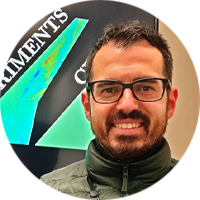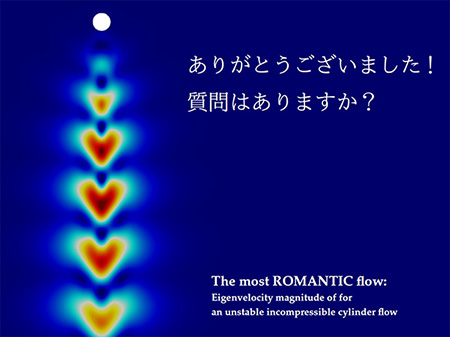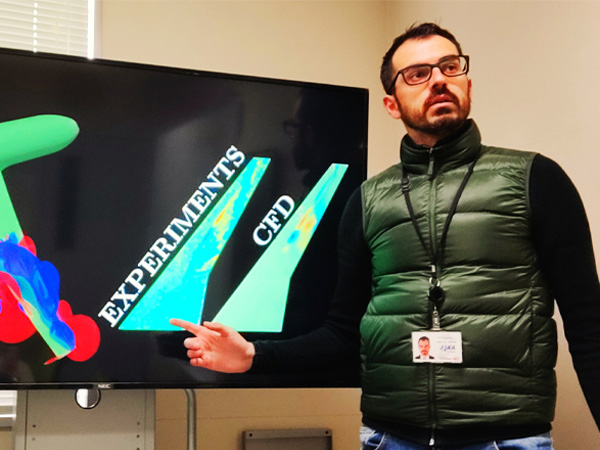― Please tell us about your current research.
I am part of JAXA’s Aircraft Lifecycle Digital Transformation (DX) project. Our objective is to create a “digital version” or “digital twin” of the physical aircraft, on which we aim to perform design studies, new concept exploration, certification and many other operations. By performing these activities on the digital aircraft rather than on the physical one, we can significantly reduce time and costs, with the idea that “moving electrons is faster and cheaper than moving atoms”. Currently, I am working in collaboration with numerical and experimental researchers at JAXA on the development of novel physics-based and artificial intelligence(AI)-based simulation tools to support the digital aircraft design phase. By accurately testing and verifying these tools, we can improve the aircraft performance and safety. This is a very exciting project because it will bring to life the next generation aircraft, that will be more environmentally sustainable and safer.
― Could you explain what sort of phenomena does this image, also posted on SNS, indicate please?
To support the aircraft digital design phase, I am developing a numerical tool based on JAXA’s code “FaSTAR”. An important step in the development of a numerical software is the “verification and validation” step, during which the developer performs tests and comparisons against other existing software and/or experiments to make sure the numerical tool is working correctly. During one of these validation tests that I was doing on a 2D incompressible cylinder flow, I discovered that by plotting the magnitude of the perturbation velocities some heart-shaped structures appeared in the unsteady wake of the cylinder. Jokingly, I named the 2D incompressible cylinder flow “The most romantic flow”.
― Why did you apply to JAXA Aviation Technology Directorate? Was there any trigger or reason?
The Aviation Technology Directorate at JAXA is one of the world-leading institutes carrying out cutting-edge research in aeronautical sciences. As well as operating many wind tunnels, I was most attracted by the possibility to use JSS3, one of the most powerful supercomputers in the world. Experimental and numerical researchers here have the possibility to directly collaborate. This is a unique characteristic of JAXA Aviation that pushes R&D towards impactful contributions and innovations, that I deeply value.
― Please tell us about the joy and challenges of your research.
The creation of reliable simulation tools is a very complex problem, because there are many sources of uncertainties that we need to be able to control and eliminate. This is an extremely difficult task that poses many interesting challenges and we are working very hard to succeed and create novel technologies. These challenges are pushing experimental and numerical researcher to work closely together, and also promoting collective synergy between international aeronautical academic and industrial communities. This unprecedented global collaborative effort is an exciting opportunity of growth for all members of the aviation industry.
― What are your future goals?
Since I joined JAXA, I have been actively creating and participating to domestic and international collaborative projects with both universities and national research centers. An example is the participation to the working group of the Internaiontal Forum for Aviation Research (IFAR), to identify emerging opportunities and challenges from using Deep Learning in CFD. One of my main goals for the future is to continue to support and strengthen JAXA’s connections and relationships with researchers and institutes from all around the world.
― What message would you like to give to younger people who want to join JAXA’s Aviation Technology Directorate?
The Aviation Technology Directorate is the perfect place for motivated young researchers that want to take on great challenges and work at the forefront of aeronautical sciences. We have one of the largest clusters of wind tunnels in Japan, excellent flight test facilities and one of the most powerful supercomputers in the world. Young researchers will have the possibility to do impactful work with internationally renowned experts, as well as pursuing advanced R&D activities alongside Japanese and foreign universities and industries.
My favourite places in Tokyo
Inokashira Park is one of my favourite places in Tokyo. The pond and the tall trees are gorgeous and they make you forget about being in a big crowded city. In spring, it is possible to admire the elegance and delicateness of Sakura, as well as enjoying hanami with friends. Benzaiten temple is built on the edge of the pond and when I need to destress and relax, I always go running or take a walk in this peaceful place. For the lovers of Miyazaki’s work, Inokashira is also home to Ghibli Museum, where I have now been many times. Whenever I have friends visiting from abroad, Inokashira Park is always on the top of my “places to see list” and everybody falls in love with it!
Updated on June 6, 2022



